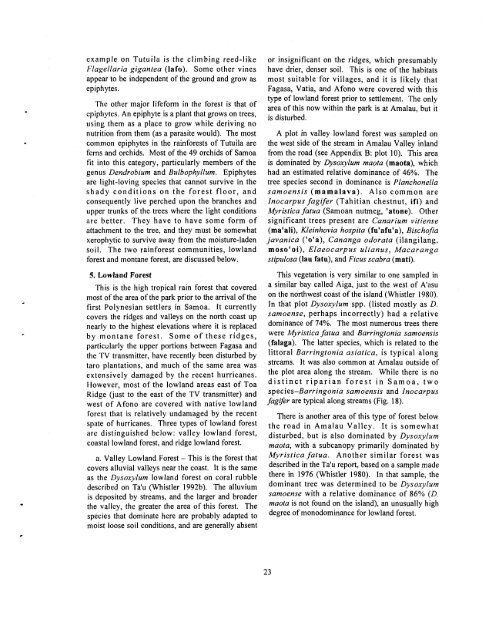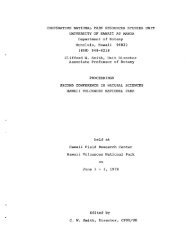american samoa - University of Hawaii at Manoa
american samoa - University of Hawaii at Manoa
american samoa - University of Hawaii at Manoa
Create successful ePaper yourself
Turn your PDF publications into a flip-book with our unique Google optimized e-Paper software.
example on Tutuila is the climbing reed-like<br />
Flagellaria gigantea (lafo). Some other vines<br />
appear to be independent <strong>of</strong> the ground and grow as<br />
epiphytes.<br />
The other major lifeform in the forest is th<strong>at</strong> <strong>of</strong><br />
epiphytes. An epiphyte is a plant th<strong>at</strong> grows on trees,<br />
using them as a place to grow while deriving no<br />
nutrition from them (as a parasite would). The most<br />
common epiphytes in the rainforests <strong>of</strong> Tutuila are<br />
ferns and orchids. Most <strong>of</strong> the 49 orchids <strong>of</strong> Samoa<br />
fit into this c<strong>at</strong>egory, particularly members <strong>of</strong> the<br />
genus Dendrobium and Bulbophyllum. Epiphytes<br />
are light-loving species th<strong>at</strong> cannot survive in the<br />
shady conditions on the forest floor, and<br />
consequently live perched upon the branches and<br />
upper trunks <strong>of</strong> the trees where the light conditions<br />
are better. They have to have some form <strong>of</strong><br />
<strong>at</strong>tachment to the tree, and they must be somewh<strong>at</strong><br />
xerophytic to survive away from the moisture-laden<br />
soil. The two rainforest communities, lowland<br />
forest and montane forest, are discussed below.<br />
5. Lowland Forest<br />
This is the high tropical rain forest th<strong>at</strong> covered<br />
most <strong>of</strong> the area <strong>of</strong> the park prior to the arrival <strong>of</strong> the<br />
first Polynesian settlers in Samoa. It currently<br />
covers the ridges and valleys on the north coast up<br />
nearly to the highest elev<strong>at</strong>ions where it is replaced<br />
by montane forest. Some <strong>of</strong> these ridges,<br />
particularly the upper portions between Fagasa and<br />
the TV transmitter, have recently been disturbed by<br />
taro plant<strong>at</strong>ions, and much <strong>of</strong> the same area was<br />
extensively damaged by the recent hurricanes.<br />
However, most <strong>of</strong> the lowland areas east <strong>of</strong> Toa<br />
Ridge (just to the east <strong>of</strong> the TV transmitter) and<br />
west <strong>of</strong> Afono are covered with n<strong>at</strong>ive lowland<br />
forest th<strong>at</strong> is rel<strong>at</strong>ively undamaged by the recent<br />
sp<strong>at</strong>e <strong>of</strong> hurricanes. Three types <strong>of</strong> lowland forest<br />
are distinguished below: valley lowland forest,<br />
coastal lowland forest, and ridge lowland forest.<br />
a. Valley Lowland Forest - This is the forest th<strong>at</strong><br />
covers alluvial valleys near the coast. It is the same<br />
as the Dysoxylum lowland forest on coral rubble<br />
described on Ta'u (Whistler 1992b). The alluvium<br />
is deposited by streams, and the larger and broader<br />
the valley, the gre<strong>at</strong>er the area <strong>of</strong> this forest. The<br />
species th<strong>at</strong> domin<strong>at</strong>e here are probably adapted to<br />
moist loose soil conditions, and are generally absent<br />
or insignificant on the ridges, which presumably<br />
have drier, denser soil. This is one <strong>of</strong> the habit<strong>at</strong>s<br />
most suitable for villages, and it is likely th<strong>at</strong><br />
Fagasa, V<strong>at</strong>ia, and Afono were covered with this<br />
type <strong>of</strong> lowland forest prior to settlement. The only<br />
area <strong>of</strong> this now within the park is <strong>at</strong> Amalau, but it<br />
is disturbed.<br />
A plot in valley lowland forest was sampled on<br />
the west side <strong>of</strong> the stream in Amalau Valley inland<br />
from the road (see Appendix B: plot 10). This area<br />
is domin<strong>at</strong>ed by Dysoxylum maota (maota), which<br />
had an estim<strong>at</strong>ed rel<strong>at</strong>ive dominance <strong>of</strong> 46%. The<br />
tree species second in dominance is Planchonella<br />
samoensis (mamalava). Also common are<br />
Inocarpus fagifer (Tahitian chestnut, ifi) and<br />
Myristica f<strong>at</strong>ua (Samoan nutmeg, '<strong>at</strong>one). Other<br />
significant trees present are Canarium vitiense<br />
(ma'ali), Kleinhovia hospita (fu'afu'a), Bisch<strong>of</strong>ia<br />
javanica ('o'a), Cananga odor<strong>at</strong>a (ilangilang,<br />
moso'oi), Elaeocarpus ulianus, Macaranga<br />
st@ulosa (lau f<strong>at</strong>u), and Ficus scabra (m<strong>at</strong>i).<br />
This veget<strong>at</strong>ion is very similar to one sampled in<br />
a similar bay called Aiga, just to the west <strong>of</strong> A'asu<br />
on the northwest coast <strong>of</strong> the island (Whistler 1980).<br />
In th<strong>at</strong> plot Dysoxylum spp. (listed mostly as D.<br />
samoense, perhaps incorrectly) had a rel<strong>at</strong>ive<br />
dominance <strong>of</strong> 74%. The most numerous trees there<br />
were Myristica f<strong>at</strong>ua and Barringtonia samoensis<br />
(falaga). The l<strong>at</strong>ter species, which is rel<strong>at</strong>ed to the<br />
littoral Barringtonia asi<strong>at</strong>ica, is typical along<br />
streams. It was also common <strong>at</strong> Amalau outside <strong>of</strong><br />
the plot area along the stream. While there is no<br />
distinct riparian forest in Samoa, two<br />
species-Barringonia samoensis and Inocarpus<br />
fagifer are typical along streams (Fig. 18).<br />
There is another area <strong>of</strong> this type <strong>of</strong> forest below<br />
the road in Amalau Valley. It is somewh<strong>at</strong><br />
disturbed, but is also domin<strong>at</strong>ed by Dysoxylum<br />
maota, with a subcanopy primarily domin<strong>at</strong>ed by<br />
Myristica f<strong>at</strong>ua. Another similar forest was<br />
described in the Ta'u report, based on a sample made<br />
there in 1976 (Whistler 1980). In th<strong>at</strong> sample, the<br />
dominant tree was determined to be Dysoxylum<br />
samoense with a rel<strong>at</strong>ive dominance <strong>of</strong> 86% (D.<br />
maota is not found on the island), an unusually high<br />
degree <strong>of</strong> monodominance for lowland forest.
















